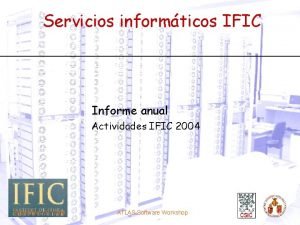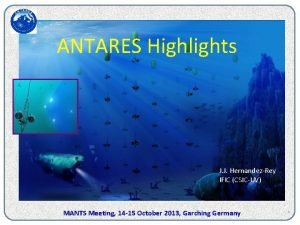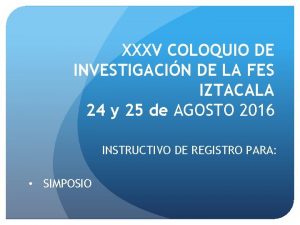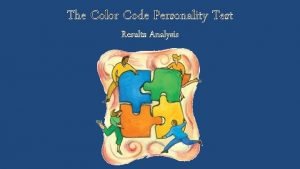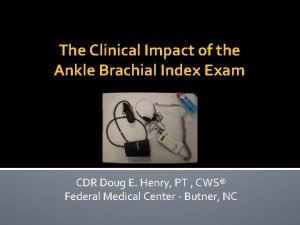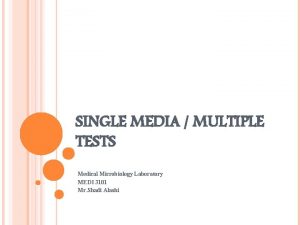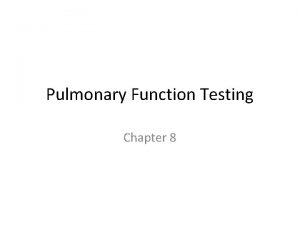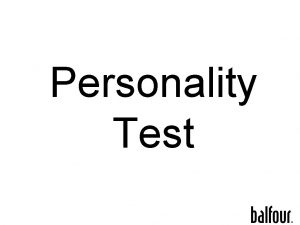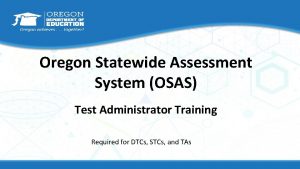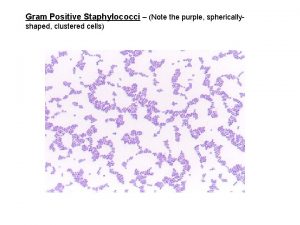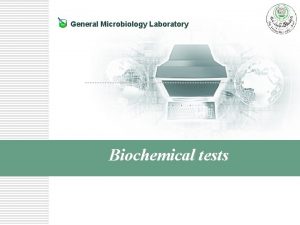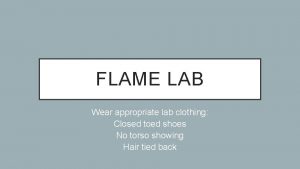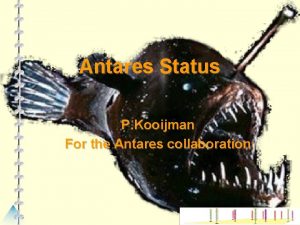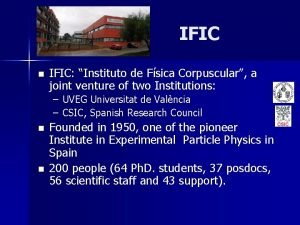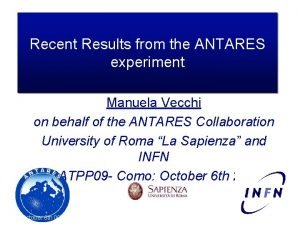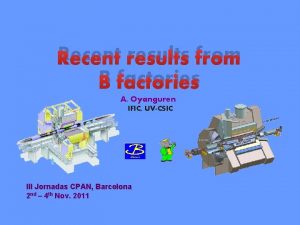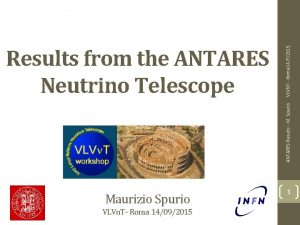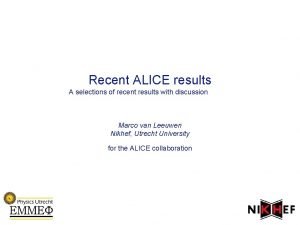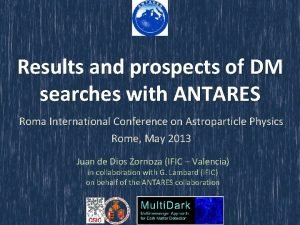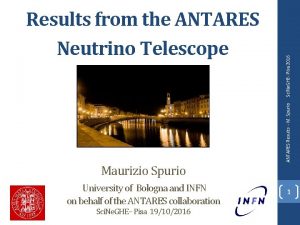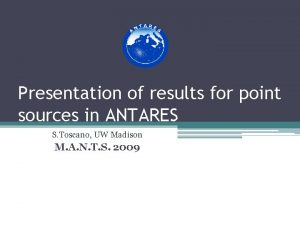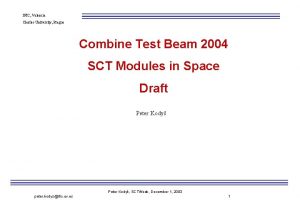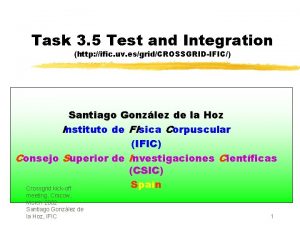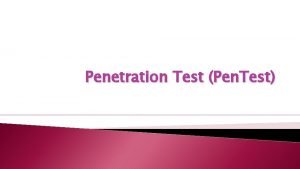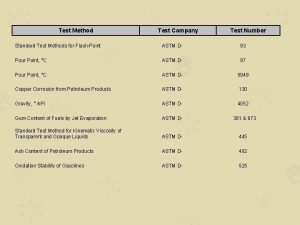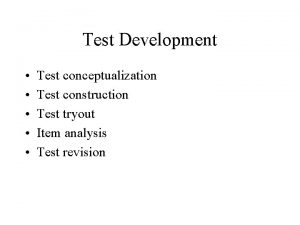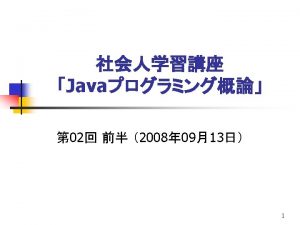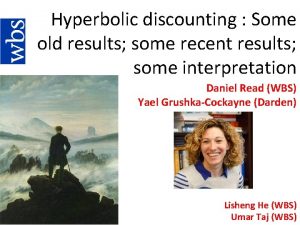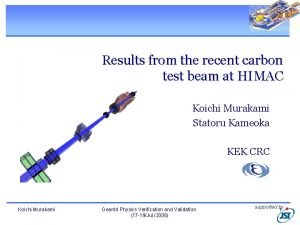Test ANTARES Recent results J J HernndezRey IFIC









































- Slides: 41

Test ANTARES: Recent results J. J. Hernández-Rey, IFIC on behalf of the ANTARES Collab. Workshop on GW & HEN, APC, Paris, 18 -20 May 2009

Deployment Data taking periods: La Seyne-sur-Mer • MILOM : Mar ’ 05 – Mar ‘ 06 • Line 1 : Mar ’ 06 - Sep ’ 06 • Line 1 -2 : Sep ’ 06 - Jan ’ 07 • Line 1 -5 : Jan ’ 07 - Dec ’ 07 (40 km) • Line 1 -10: Dec ’ 07 - May ’ 08 • Complete: May’ 08 onwards (2. 5 km depth)

(multi-) muon Event Example of a reconstructed down-going muon, detected in all 12 detector lines:

Neutrino candidate Example of a reconstructed up-going muon (i. e. a neutrino candidate) detected in 6/12 detector lines:

Accumulated data 5 lines (2007) ≥ 10 lines (2008) 19 × 106 μ triggers 65 × 106 μ triggers Cable repair Total : 245 days = 79% of calendar Selected : 168 d = 69% of total Total : 242 days = 77% of calendar Selected : 173 d = 71% of total

Line 1 measurements Width of time residuals vs. nb of hits in track fit Distribution of cosine of zenith angle. • Depth Intensity relation with a full line • Data vs. MC comparison: importance of OM efficiency at high angle for downgoing tracks AP 31 (2009) 277

Depth-Intensity relation Pr in im el Simple method based on coincidences on adjacent on next-to adjacent storeys. No reconstruction needed. y ar Rate vs. depth distribution can test OM efficiency corrections (40 K) and OM acceptance. • Uncertainties still large. More work needed. • Time distribution in agreement with MC

Pr im el 5 lines (2007) ry a in Depth vs. Intensity Pr el im in a ry Two independent analyses: Good agreement (“deconvolution” and “bin-to-bin correction”). Work on reducing systematics is ongoing

Data-MC comparison for downgoing events (5 -lines) data CORSIKA QGSJET +NSU MC uncertainty • No quality cuts applied MUPAGE data CORSIKA QGSJET +NSU CORSIKA QGSJET+Horandel • Agreement within (substantial) theoretical + MC uncertainty • Main experimental errors stem from OM efficiency and acceptance and optical water properties (λ abs λscatt)

Reducing systematics j “λatt” =57. 4 m Low light level optical beacon run • OM efficiency at high angles w. r. t. to PMT axis is a source of systematics for downgoing muons. • Measurements in lab (water tank) is difficult. • Systematics evaluated through dedicated MC simulation. • Measurements with autonomous lines. • Special beacon runs being taken to remeasure it. • Aim: 5% error level. • Delicate measurement: different sources of systematics, deconvolution of absorption and scattering.

5 line data (2007) angular distribution 168 active days 168 upward events (multi-line fit) up horizontal down

Two independent methods Observed: 168 events Observed: 185 events MC: 164± 3 (stat)± 33(theor)± 16 (syst) MC: 218± 4 (stat) ± 41(theor) + 3 (syst) − 42

2008 data 174 active days 582 upgoing events (multi-line fit) >103 reconstructed neutrinos (January 2009)

Point source search Distribution of time residuals • Stringent cuts to ensure low background and good resolution. • Search applied to 25 selected sources. • Two independent statistical methods used : one binned another unbinned. • Blinding policy followed and several “challenges” performed on scrambled data before final analysis.

List of 25 sources No significant excess found Point source search 5 -line data, 168 days 94 upgoing events

GCN alerts trigger the recording of all the low level triggers. A continuous buffer ensures the availability of the data before the alert t = -20 s t=0 s Data taking triggered by a satellite (FERMI; SWIFT, INTEGRAL) t = 20 s All data is written to disk t = 200 s Specific data filtering and reconstruction by searching for an excess of events in the GRB direction (offline) t=1 h

GRB Analysis black: GRB alerts received Nb Cumulative of alerts/month nb of alerts red: the ones Antares triggered on 8. 6 TB on disk Response time to alerts Un of fic ial plo t Time (date) • 500 alerts from GCN 390 have been recorded (Jan´ 09) • Two independent analyses are being performed for the 5 -line data. • An unblinding request is expected to take place very soon. Signals are expected to be small but the limit on the GRB flux after 5 years skims the predictions of W&B

Dark matter search 5 lines, 68 days, ν flux Фνμ+νμ from the Sun 5 -line data, 68. 4 days 168 days + 51% Sun under horizon + trigger corr. No excess observed (90% C. L. limits à la Feldman-Cousins) m. Sugra model predictions green : WMAP favoured relic density red : > WMAP favoured relic density blue : < WMAP favoured relic density

Dark matter search 5 lines, 68 days, μ flux Фμ+μ from the Sun ANTARES (5 lines, 68 days) Macro (4. 89 years) Baksan (10. 6 years) Super. K (4. 6 years)

Dark matter search 12 lines, 5 years, ν flux Фνμ+νμ from the Sun Simple extrapolation 12 lines, 5 years Effective Area 12 lines instead of 5 → factor = 12 / 5 = 2. 4 Data taking 5 years (total data taking period) 0. 9 (data taking efficiency) 0. 8 (trigger deadtime) 0. 5 (sun under horizon) = 657. 45 effective days → factor = 657. 45 / 68. 4 = 9. 6 Total factor = 2. 4 * 9. 6 = 23

Multi-messenger approach Agreement with TAROT Telescopes à Action Rapide pour l’Observation de Transients) • TAROT: two 25 cm telescopes at Calern (France) and La Silla (Chile) • FOV 1. 86⁰ x 1. 86⁰ • ~10 s repositioning after alert reception Priorities (decreasing with time) are set to alerts. SWIFT has the highest priority ANTARES alert • Two events with ΔΩ < 3⁰ x 3⁰ Δt < 15 min • Rate(atm) = 0. 05 yr-1 • Work is quite advance (on-line reconstruction and selection). • Fake alerts have been sent to test the connection to TAROT. • Conditions of the agreement are being discussed.

Multi-messenger approach Pierre Auger Observatory Ongoing talks on: • restricted access to non-published data. • rules for possible common publications Correlation of UHECRs with AGNs positions: 20 out of 27 CRs with E>57 Ee. V correlate (within 3. 2 o) with nearby AGNs from the Véron-Cetty&Véron catalogue ( 292 AGNs with D < 75 Mpc).

Multi-messenger approach • Possible common sources (GRB-core collapse into BH; SGR – powerful magnetars; hidden sources) • Sky regions in common • Expected low signals, coincidences increase chances of detection • GW & HEN is a must

Acoustic detection Transients from mammals • AMADEUS comprises a series of hydrophones in IL and Line 12 • This is a test bench to study the feasibility of a large acoustic UHE neutrino detector • Study of acoustic environment and backgrounds • Methods to reconstruct direction (beamforming, time differences)

Other Analyses Skymap of downgoing muons • MILAGRO observes a large scale (~ x 10⁰) cosmic ray anisotropy (0. 1%) at an average energy ~6 Te. V • Anisotropy in Ice. Cube? • Requires good control of all corrections: visibility, zenith angle, μ propagation • Downgoing muons from gammas (direct pair production, through pions, etc) • Can extend GRBs or SGR fluxes to Te. V gammas, look for giant flares • Analysis ongoing, low fluxes expected

Other Analyses • Chemical composition of cosmic rays • Algorithm to count showers along muon tracks has been developed. • Sensitive to energy and number of muons in bundle. • Feasibility being studied

Other Analyses ANTARES sensitivity to monopoles (5 -line detector and 127 days) ANTARES 5 lines AMANDA II 137 days • Search of monopoles • Extremely high energy deposition • Direct Cherenkov light for > 0. 74 • Through δ-rays for > 0. 51 • Monte Carlo generation done (study of trigger efficiencies, selection, background rejection etc. ) • Good prospects for limits • A dedicated reconstruction needed • Search of nuclearites (strangelets, quark nuggets, Q-balls). • Very characteristic signature: an extended source of photons “heated wire” • Analysis ongoing. Good prospects for limits

Summary • The ANTARES telescope took data • The search for point-like sources with the 5 -line data has provided in its 5 -line configuration in 2007 and is taking data with 10 or more the more stringent upper limit for lines since Dec 2007. the southern sky. Work on ≥ 10 line detector is ongoing. • Work on the full understanding of • The multi-messenger approach is the detector is proceeding well. Downgoing tracks are especially being strongly pursued in useful (and challenging) for this. ANTARES: LIGO/VIRGO, GCN, Work on reducing systematics is TAROT, Auger). For expected low ongoing. level signals this is a must. • More than 1000 upgoing events • While the deployment of a still have been reconstructed (Jan 09). larger telescope in the northern hemisphere (KM 3 Ne. T) takes place, ANTARES could give some surprises. Agreement with MC is good, further work is needed to ascertain that the expected performances have been reached (angular resolution, effective area, etc).

Backup slides

Methods of point-like sources search The background from atmospheric neutrinos and muons will be dominant. It is crucial to have an algorithm able to point out the accumulation of the signal events over this background. The background is right ascension independent and declination dependent. ANTARES: Very good angular resolution: < 0. 3º for En > 10 Te. V. δ = 47º Sources are visible up to d = 47º. GC is visible (63% of the time). • Background-like Binned methods: – Grid (square shape). – Cone (circular shape). • Unbinned methods: – ML ratio. – EM. Signal-like ? ?

BIN: Cone method In the all sky search each event is taken as the cone centre. In a fixed-source search the source position is taken as the cone centre. The cone size is optimized to get the better signal/background ratio: MDF (all sky search) and MRF (fixedsource search). The probability for the background to produce a given number of events can be computed analytically. d RA Pi is the probability for the background to produce the observed number of events N 0 or more (up to the maximum number Ntotal). is each element of the set Cn. Ntotal of combinations of Ntotal elements in groups of n elements. Probability for the event j to be inside the cone defined for the event i.

Signal & Background BIN: Cone method The number of background events (nb) inside the cone is estimated from the real data. The PSF is obtained from MC assuming a flux of E-2.

Cone size optimization BIN: Cone method Optimum radius (deg) MRF Upper limit Poisson weight MRF = d = -30° rbest~ 3° Model Rejection Factor used for fixed -source search cone radius (deg) declination (deg) Optimum radius (deg) MDF Model Discovery Factor used for all-sky search d = -15° rbest~ 2. 5° cone radius (deg) declination (deg)

UNBIN: EM algorithm EM is a general approach to maximum likelihood estimation for finite mixture models. Mixture models: different groups of data are described by different density components. g = number of mixture models pi = mixture proportions, where Previous step: change from incomplete to complete data set. The vector zi is a class indicator that indicates if the event i belongs to the background or the source. Expectation step –Start with a set of initial parameters Ψ(m) = {π1, π2, µ, Σ} –Expectation of the complete data log-likelihood, conditional on the observed data {x} Maximization step –Find Ψ = Ψ(m + 1) that maximizes Q(Ψ, Ψ(m))

UNBIN: EM algorithm Signal & background A simple pre-clustering selects a set of candidates by using a cone of 1. 25º around each event of the sample. Background Signal Sample Background from real RAscrambled data Signal pdf model 2 D-Gaussian signal : αRA, δ position of event: bg: only δ x = (αRA, δ) Samples simulation: § § 104 samples simulated. Each sample corresponds to the lifetime of 2007 data period. The Bayesian Information Criterion (BIC) is chosen as the test statistic of the method. Background like Signal like 104 samples

RESULTS

Fixed-source search RESULTS 24 sources in the ANTARES field of view have been selected among the most promising neutrino source candidates (galactic and extragalactic) for the 5 Line point-like source analysis. Sky map in galactic coordinates 24 selected sources + Ice. Cube Hot Spot (d= 11° a = 153°) Sky coverage of 3%

Fixed-source search RESULTS The p-value is the probability of the background to produce the measured (or higher) observable (BIC for the EM algorithm or nevents for the con method). The. P-values lowest q ≠ 1 found value for 4 corresponds to list. a p-value sources in our pre-trial of 2. 8 found with UNBINNED method. It is expected in 10% of the experiments when looking at 25 sources (post-trial probability). Probability distribution of the background when we look at the 25 positions in the sky: the probability The low p-value is due to to find 4 (or more) the position of the events in our is of very close to cones the source about 33% location.

Fixed-source search RESULTS Upper limits obtained with 2007 data (5 lines), compared with 1 year of complete detector (12 lines) and other experiments.

All-sky search RESULTS Sky map with the 94 events selected for point-like source analysis with 2007 data. First neutrino sky map of ANTARES

All-sky search RESULTS BIC distribution of only background BICobs EM algorithm In our sample : BICobs = 1. 4 (highest value) p-value = 0. 3 (1 excess) (d = -63. 7º RA =243. 9º) No significant excess was found Cross-check: Cone method ANTARES Coll. Meeting d RA Nevents PBIN -28. 8 31 1 0. 053 -42. 7 164 1 0. 050 24. 2 32 1 0. 069 -51. 4 159 1 0. 052 -63. 38 244 1 0. 055
 A friend emails you the results of a recent high school
A friend emails you the results of a recent high school Horde ific
Horde ific Brific
Brific Br ific
Br ific Veolia
Veolia Ies antares
Ies antares Antares iztacala
Antares iztacala How are barnard's star and antares alike
How are barnard's star and antares alike Antares
Antares Recent trends in ic engine
Recent trends in ic engine Recent developments in ict
Recent developments in ict Recent developments in object detection
Recent developments in object detection Many recent college graduates have faced
Many recent college graduates have faced Trends in india foreign trade
Trends in india foreign trade Reading scanning
Reading scanning Modern trends in project management
Modern trends in project management Recent demographic changes in the uk
Recent demographic changes in the uk Recent activitycourse dashboard
Recent activitycourse dashboard Geotaphonomy
Geotaphonomy After kato's serious motorcycle accident
After kato's serious motorcycle accident Recent advances in dental ceramics
Recent advances in dental ceramics News headlines in passive voice
News headlines in passive voice Https://drive.google.com/drive/
Https://drive.google.com/drive/ Udin login
Udin login Emerging trends in mis
Emerging trends in mis Comait
Comait Christian love language test
Christian love language test 5 love languages test
5 love languages test Colourcode personality test
Colourcode personality test Color blue personality
Color blue personality Abi values
Abi values Tsi test: principle
Tsi test: principle Kligler iron agar test results
Kligler iron agar test results Pulmonary function test results
Pulmonary function test results Draw pig personality test
Draw pig personality test Osas oregon
Osas oregon Thomas test results
Thomas test results Casein hydrolysis test results
Casein hydrolysis test results Methyl red test
Methyl red test Nitrate reduction test staphylococcus aureus
Nitrate reduction test staphylococcus aureus Starch
Starch Where else have you observed colorful light emissions
Where else have you observed colorful light emissions

